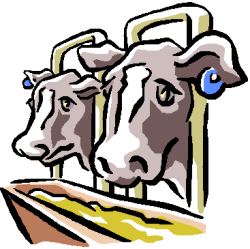

To send a message to an author, click on the author's name at the end of the article.
This Month in Ag Connection | Ag Connection - Other Issues Online
Many producers are looking for ways to stretch limited hay supplies. Chopping and ensiling corn is by far the best way to deal with this situation. Ensiling allows for more complete consumption of the drought-damaged corn. Ensiling also reduces the nitrate concentration of the feed by 20 to 50 percent. Drought-damaged corn silage is good feed and has nutrient quality estimates equal to or greater than good to high quality grass hay.

Feed testing less than 2,500 parts per million (ppm) is safe to feed to all classes of livestock. Feed in excess of 15,000 ppm is unsafe to feed. Feed with nitrate between these two levels can be blended with feeds containing no nitrate and/or grain. It is vital to know the nitrate level of feed ingredients in order to correctly formulate safe rations.
Plants causing most concern are corn, sorghum, and other summer annuals that have received nitrogen fertilizer. It is rare that grass hay contains nitrate in levels that cause problems. In fact, grass hay is needed to blend with higher nitrate feeds in order to develop safe feeding programs.
I am recommending producers that chop corn for silage send a sample for nutrient analysis and nitrate concentration after they open up the silo for feeding. This will provide information on the actual concentrations of nutrients and nitrates in the final product being fed. While it can be informative to know nitrate levels before ensiling, it is very important to know nitrate levels in the silage after fermentation.
This can be a rather complex and serious issue for producers. Extra care is needed to understand the issue, how nitrate affects livestock, and how to blend and feed high nitrate containing feedstuffs. However, drought-damaged corn can be effectively utilized as livestock feed. Contact your local MU Extension office for more information on sampling and testing feedstuff.
Source: Gene Schmitz, MU Extension Livestock Specialist
This Month in Ag Connection | Ag Connection - Other Issues Online
The severity of the drought is detrimental to yards and gardens across the state. The economic impact to crops and the response needed to protect livestock is justifiably getting most of the attention. But over the next few months to a year many individuals will be trying to amend some of the damages to their landscaping. Briefly listed below are some comments and tips that may be helpful in those efforts.
Lawns- Most people have given up on watering lawns due the time required, water shortage, or the cost. Initially when cool season grasses go dormant (turn brown) the crown is still a little green, which you can see if you dig into the thatch and look closely. However, if no moisture is received over an extended period of time (e.g. a month to 6 weeks) many crowns will die and ‘recovery' following regular rainfall will be poor. These lawns will need to be renovated to look good, with September being the advised month for doing so. But with soil conditions being so dry, most people will wait until late winter for frost seeding or early spring for renovation. Due to the extensiveness of the drought, shortage of grass seed is anticipated for 2013. Purchasing grass seed this fall might save money and insure seed for when it is needed. Selection of the different turfgrass varieties is likely to be less next year as well. Help MU Extension guide sheets: G6705,Cool-Season Grasses: Lawn Maintenance Calendar; G6700, Cool-Season Grasses: Lawn Establishment and Renovation
Trees and woody plants- By now you have probably watched a favored tree or bush turn brown, drop leaves or something in between. Two frequent questions are "will it recover" and (assuming some parts are OK) "when can I prune it"?

1. If the tips of a woody plant are green that is a good sign that it may come back next year, even if it has shed most of the leaves (dropping the leaves is a way for the tree to reduce its water needs). But the plant might not come back; you'll only know next year for certain when it fails to leaf out. If it turned completely brown in June, July or August it is likely dead, especially so if it did so suddenly. To check snap a branch or stick to see if is limber or brittle; brittle being dead. Bigger branches or the trunk can be checked by pealing back some bark and looking for some greenish/pliable tissue. If it changed gradually and made it into late August with some greenish/yellowish leaves, then it may have gone dormant. For trees or bushes that have died there is no reason to wait to remove them. With the numbers of dead trees this year, tree service companies will be busy for some time to come, as many trees will not be identified as clearly dead until the spring. It is generally easier to imagine how you'd like to replant a landscape without the distraction of dead tree or bush in view.
2. Don't rush to prune. Waiting until next spring would be the preferred option. You can probably tell what is dead, but you might not know what might still die. A tree or bush might continue to show effects from the drought for some time. In the drought of 1999, I had a 30 foot fir tree that looked fine until November when it suddenly started to turn yellowish. It was totally dead by March. If you feel you ‘have' to prune something because of its prominence, wait until we're into cooler weather and we've had some rains (or you've watered the area well). On some trees and bushes (notably on yews) the uppermost parts directly exposed to sun have scorched brown and are probably dead. But these branches and leaves are often providing some shade (thus protecting) green leaves underneath.
Herbaceous perennials, flowers and vegetables- Wildlife feeding on flowers and vegetables increases in dry weather, something most gardeners discovered last year. For annual flowers and most vegetables, one will just plant again next spring. For herbaceous perennials, most that cannot tolerate the heat and dryness die back above ground. But the crowns should be ok, as they are at or below ground (reasonably protected). The dead foliage that collapses down on a crown serves a purpose to protect it. Severe cracking of the ground may result in damage to crowns through physical tearing or drying (the latter as air that can now easily enter the ground). Damage from cracking would be mitigated if the area was well mulched.
Source: James Quinn, Horticulture Specialist
This Month in Ag Connection | Ag Connection - Other Issues Online
Harvest is a prime time for fire dangers, especially with the extremely warm, dry conditions. Fuel sources such as leaves, stalks, husks, dust, oil and fuel are always present when harvesting fields, and so are numerous sources of ignition on farm equipment or transport vehicles including exhaust, bearings and electrical wiring. Fire safety in the field has two key components -- prevention and preparation in case a fire does break out.
The following steps will help in preventing a combine fire:

Electrical systems:
Fuel systems:
Mechanical operation:
In the field:
In addition to the combine, grain transport or pickup trucks with exhaust systems below the chassis also can ignite field fires. Catalytic converters operate at several hundred degrees. Field fires are sometimes started with the passing of a truck, and flames may not be noticed for 15 to 30 minutes. It's a good idea to not allow extra truck traffic through the field when conditions for fire are favorable.
One should remain vigilant throughout this potentially extremely warm, dry harvest season.
Source:Kent Shannon, MU Extension Natural Resource Engineer Specialist
This Month in Ag Connection | Ag Connection - Other Issues Online
Aflatoxins are a group of extremely toxic chemicals produced by two molds, Aspergillus flavus and Aspergillus parasiticus. Most of the aflatoxin problems on corn in the United States are caused by Aspergillus flavus. Drought, extreme heat and corn ear injury from insect feeding stresses the corn and create an environment favorable to these molds and aflatoxin production. Aflatoxins are harmful or fatal to livestock and are considered carcinogenic to animals and humans.

Temperatures ranging from 80 to 100 degrees F and a relative humidity of 85% are optimal for Aspergillus growth and aflatoxin production. Corn damaged by insects or weather factors such as hail, early frost that cracks the pericarp and wind storms, may also predispose the corn to infection by Aspergillus flavus.
On the corn in the field Aspergillus flavus is evident as a greenish-yellow to yellowish-brown, felt-like or powdery mold growth on or between the corn kernels.
1. Mold growth is more likely to develop adjacent to or in insect damaged kernels on ears.
2. In storage, Aspergillus flavus can also develop or continue to develop. Aspergillus flavus grows best on corn at 18.0-18.5% moisture. Moisture content below 13% prevents invasion by the fungus. Fungal growth may begin on corn at a moisture content lower than 18.0%. Aspergillus flavus grows best at high temperatures. The fungus will grow slowly in grain between 40-50 degrees F but will grow rapidly in grain at 80-90 degrees F. Corn with cracks or breaks in the pericarps or seed coats, broken kernels or other physical damage is more subject to invasion by Aspergillus flavus.
3. The presence of Aspergillus flavus on corn does not necessarily mean that aflatoxin is also present in the corn. Circumstances that favor mold growth may also favor mycotoxin production but mold growth may also occur with little or no mycotoxin production.
Aflatoxin does not occur uniformly through a lot of grain and is usually localized in a small area. The best approach to sampling is to make a composite sample consisting of subsamples from every part of a load, bin, or unit of corn. A sample size of 5 or 10 pounds is recommended. There are two types of screening tests available: blacklight tests and commercial tests. Both of these tests are designed to detect the presence of aflatoxin primarily. The blacklight (also called ultraviolet test) is a visual inspection for the presence of a greenish gold fluorescence under a wavelength of 365 nm. The greenish gold fluorescence looks like a firefly glow. Also, commercial test kits with immunoassay or ELISA techniques are available for on-site tests for the presence of aflatoxin. If the presence of aflatoxin is positive, samples need to be sent to a lab for verification and quantification.
Source: Wayne Crook, Agronomy Specialist
The conclusion to Horseback Riding Safety will be in the October Issue. Sorry for the inconvenience.
This Month in Ag Connection | Ag Connection - Other Issues Online
Publishing Information
Ag Connection is published monthly for Northeast and Central areas of Missouri producers and is supported by the University of Missouri Extension, the Missouri Agricultural Experiment Station, and the MU College of Agriculture, Food and Natural Resources. Managing Editor: Mary Sobba.